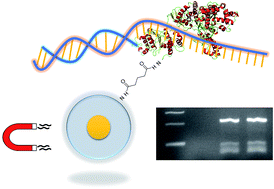Magnetic silica nanoparticle–Taq polymerase hybrids for multiple uses in polymerase chain reaction
Abstract
Enzyme-magnetic nanoparticle hybrids have been employed as a strategy to improve the biocatalytic usability of biological molecules. For this purpose, we synthesized magnetic core–silica shell nanoparticles for direct one-step easy immobilization of Taq polymerase from a crude extract preparation. The hybrid magnetic particles were synthesized by a magnetic co-precipitation method. The magnetic particles were then coated with a 3-(triethoxysilyl)-propylamine (APTES)/tetraethoxysilane (TEOS) mixture, and the pendant –NH2 groups subsequently functionalized with glutaraldehyde for simultaneous immobilization of Taq-polymerase. The magnetic properties of the particles contributed to fast purification to eliminate inhibitory elements present in the crude extract during Taq polymerase isolation. The Taq–silica hybrid material performed with a similar efficiency to the solution-phase enzyme. Additionally, the new hybrid material allowed reuse of the enzyme multiple times. The silica–Taq polymerase hybrid lost 16% of its activity after 6 cycles. Most importantly, the silica microparticle immobilization extended the functional life of Taq polymerase at room temperature by facilitating a fast cleaning procedure.



 Please wait while we load your content...
Please wait while we load your content...